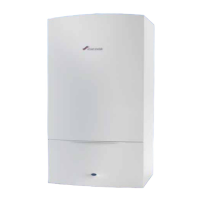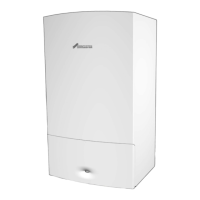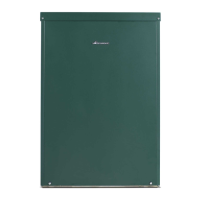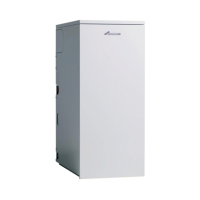SERVICE AND SPARES
CDi Compact
ErP
- 6 720 813 276 (2015/07) 45
▶ Set the boiler to minimum power by pressing the down arrow button.
– “Min” will flash at the bottom left of the screen.
– The boiler will take 30 to 35 seconds to ramp down to minimum
output.
– Allow the boiler to stabilise at minimum output.
▶Check the CO/CO
2
readings against those in tables 27 and 28
▶ Return the boiler to maximum, by pressing the UP arrow button, and
re-check the CO/CO
2
.
– “Max” will flash at the bottom left of the screen.
– The boiler will take approximately 30 to 35 seconds to ramp up to
maximum output.
– Allow the boiler to stabilise at maximum output.
▶ If correct, press the button and the boiler will return to normal
operation.
▶ Re-assemble and refit boiler case.
Example of a Natural Gas appliance reading:
•Maximum CO
2
reading taken = 9.5%
• The minimum CO
2
reading must be between 8.0% and 9.3%
(a minimum 0.2 lower than the maximum reading of 9.5%)
If the CO
2
is out of tolerance then please check:
▶ the gas inlet pressure,
▶the gas rate,
▶ the fan test pressure,
▶ the condition of burner,
▶ the flue and air intake, plus any possible blockages in the condensate
disposal.
▶ for leaks or obstructions in the gas way,
▶ that the injector is clean.
After all checks have been and the CO
2
is still out of tolerance then the
gas valve must be replaced.
7.7 Cleaning the heat exchanger
The following items will have to be removed to gain access to the heat
exchanger for cleaning:
▶ Lower the control panel into the service position.
▶ Remove the case.
▶ Disconnect electrical wires to the fan, ignition transformer, spark
electrodes, flue overheat thermostat, main heat exchanger
temperature sensor and flow pipe temperature sensor.
▶Flueway
▶Fan assembly
▶ Ignition transformer
▶ Spark electrode assembly
▶ Burner housing, burner and gasket
Refer to sections 7.8.10 to 7.8.14 for instructions on how to remove
the items to gain access to the heat exchanger channels so that the heat
exchanger can be cleaned
7.7.1 Cleaning the siphon
1. Protect the controller from water ingress and disconnect the black
discharge hose from the wall frame connector.
2. Rotate the siphon body clockwise to release the bayonet connection.
3. Pull the siphon body down and away from the boiler.
▶ Empty the water and debris into a suitable container.
▶ Visually inspect the siphon to ensure that it is clean and free from
debris.
Fig. 72 Cleaning the siphon
Refitting the siphon
▶ Fill siphon with 200 to 250 millilitres of water.
1. Push the siphon up onto the sump assembly until it fully engages with
the sump connection.
NOTICE: Minimum CO
2
▶ The minimum CO
2
reading must be at least 0.2 lower
that the maximum CO
2
reading.
NG Appliances
Output CO
2
Reading CO Reading
Maximum setting
(measured after
10 minutes
Between 8.5 and 10.1. Less than 200ppm
Minimum setting
(measured after
10 minutes
A minimum 0.2 lower than the
maximum reading taken but
above 7.5%
Less than 50ppm
Table 27 NG CO/CO
2
settings
LPG Appliances
Output CO
2
Reading CO Reading
Maximum setting
(measured after
10 minutes
Between 9.8 and 11.1. Less than 200ppm
Minimum setting
(measured after
10 minutes
A minimum 0.2 lower than the
maximum reading taken but
above 8.5%
Less than 50ppm
Table 28 LPG CO/CO
2
settings
NOTICE: Gaskets and seals
▶ Replace the burner and electrode assembly gaskets
and the Flueway sump seal after cleaning the heat
exchanger.
Do not attempt the cleaning procedure unless new
gaskets and seals are available.
There is an optional tool available to assist in cleaning the
heat exchanger, part number 7 746 901 479
NOTICE: Do not use solvents, adhesive or lubricant
when pushing the pipe onto the rubber connector.
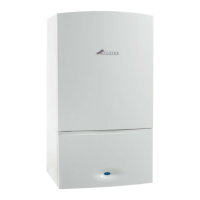
